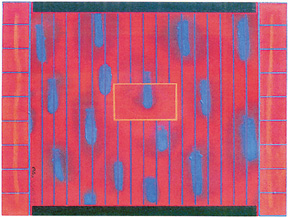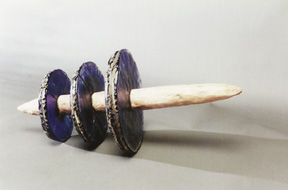
Otherworldly
The early 19th-century Horace Williams House hosts
work that appears to be from the 22nd.
B Y E L I N O ' H A R A S L A V I C K
and Alex Wilhite is visiting the Greek Revival-style Horace Williams House, built in
1840 by local craftsmen and now home to the Preservation Society of Chapel Hill. The
exhibition begins in the foyer, crowned by a tongue and groove beaded pine ceiling, with
two paintings by Alex Wilhite. With your visual senses already heightened by the
architecture and history of the house, you proceed to the main part of the exhibition in the
Octagon Room. A small and intimate room filled with natural light streaming through
wavy glass windows and clean track lighting, it is a perfect space for exhibiting and
looking at art.
Alex Wilhite, who received his bachelor's degree in fine art
from the University of North Alabama and a master's of
fine art from Pratt in Brooklyn, N.Y., describes himself as
an "abstract illusionist deeply interested in combining
hard-edge paintings with a flowing action." A deaf artist, Wilhite has recently received a
cochlear implant "to overcome the barrier of communication and to create a bridge to new
art worlds." Knowing about the implant informs the experience of viewing Wilhite's
work. Each of his Spectroscopic oil and acrylic paintings functions as a 2-D visual
representation of sound. "Prism of Rain Drop III" seems to illustrate video artist Bill
Viola's concept of a raindrop or molecule being a microcosm of the entire universe. In the
painting, Wilhite superimposes a set of hot red parallel lines over a swirling blue and
yellow volcanic landscape. The red lines read as an aerial grid, a mathematical, military, or
scientific mapping system to order, control or divide the land that is organically abstract.
Miles of space appear to separate the red lines and the blue land.

Courtesy Of Alex Wilhite
"blue raindrops," by Alex Wilhite
charred black lumps and fiery flames of yellow framed by the artist's signature hard-edge
border of deep gray, shocking red and cobalt blue. His borders are almost miniature
Rothkos, luscious color fields. His intention to combine hard-edge painting and a more
organic flow results in shifting optical illusions. "September 11, 2001" reminds me of
Ross Bleckner's paintings done as memorials to those who died from AIDS, but Wilhite
adds a floating schematic of a bed--a red outline of a suspended rectangle. At first glance
it is an empty line drawing of a mattress receding in space. Look at it for a while,
however, and it seems to rise up, the front becomes the bottom, and the back suddenly the
top, like a sawed-off pyramid. Open to interpretation, like all abstraction, the painting
provides a space for contemplation, mourning, and an odd sense of spiritual resurrection.
Wilhite's other two most interesting paintings are "Sound of Gray Raindrops" and "Birth
of Venus in Space." The first is framed by gray and white hard edges that surround a
field of watery yellow smeared by about 30 strokes of thick metallic gray blobs:
raindrops, thumbs, dark ghosts, shadows or ashes floating up to the bonfire-lit night sky?
One gray drop is boxed off from the rest by a deep purple rectangle. Is this one Wilhite,
the individual within society, or the one raindrop that signifies the whole rain? "Birth" is
the only painting without Wilhite's hard-edge framing device. Again, reminiscent of Ross
Bleckner's paintings of hovering orbs and dimly lit spirits, floating urns and transparent
chalices, this painting is a Rorschach test turned sideways. Two diagrammatic line
drawings of Wilhite's now familiar rectangles (which I can't help but read as beds) meet
at their ends, opening up like a book or the corner where two walls meet. But these beds
open like a mouth, up and down, not side to side, and they bite out at us from a deep maw
of silvery blackness, red shooting stars or meteorites traveling horizontally, a pink galaxy
arching and subtle yellow illumination bathing this "Birth of Venus" in a warm glow.
Venus, the goddess of love, has been dispersed, setting off sparks and leaving pools of
light and fire in the dreaded darkness.
Meanwhile, Kristin Gudjonsdottir's ceramic, cast glass, copper, cast iron and stone
sculptures seem to have landed here from one of Wilhite's deep spaces. Earthen in tone,
as if buried for years, Gudjonsdottir's seemingly abandoned or found lumps sit on
pedestals like toys, mini-UFOs or geodes. These forms merge the rough and opaque
nature of clay and metal with the beauty and translucency of glass.
Gudjonsdottir grew up in Iceland and received her BFA from the California College of
Arts and Crafts. Her work is heavily influenced by visits to the isolated northwest corner
of Iceland where, as a child digging in the ground, she would come across mysterious
tools of her ancestors. She also says she is influenced by the "ideology of recycling and
nature preservation of the Bay Area of California."
"Blue and Green Spindle Form II" is like a top, a gigantic two-pronged jack with a milky
green glass tip and a cobalt blue one. Like Louise Bourgeois' earlier works of
marvelously organic and bizarre sculptures of marble and glass, Gudjonsdottir's
otherworldly forms speak from memory, of foreign places, and combine different
psychological or emotional states through the use of materials. "Three Cone Form," like a
witch's hat, balances on its two glassy teeth, cones of blue and green glass like feet
beneath a heavy dunce cap of clay topped with a larger tooth of green, blue and white
glass that shimmers like sno-cone ice.

Courtesy Of Kristin Gudjonsdottir
"Three Disk Form," by Kristin Gudjonsdottir
washed up on shore from years at sea, like a tangle of seaweed or awkward jellyfish. The
sculpture has a blue glass body that has grown a clay cone limb surrounded by metal
tentacles. Each tentacle is made up of many strands of copper wire. This form wants to
swim. Unfortunately, it rests on a table near the window; I want to see it on the floor. In
fact, most of Gudjonsdottir's sculptures would work better on the floor, or on lower,
flatter pedestals, or even on beds of organic matter. Displayed in this way, they would
really come alive. All of them, unfortunately, rest on standard white pedestals pushed to
the windows. While the natural light illuminates their incredibly worked surfaces and the
contrast between bold and subtle colors, their placement so close to the windows makes it
impossible to get around them, to examine these artifacts or fallen treasures in all their
strange glory. Gudjonsdottir is quite skilled with her materials and each sculpture is
remarkable. Like blazing and milky gems, Wilhite's paintings and Gudjonsdottir's
sculptures work together to make a dynamic and semi-precious exhibition.